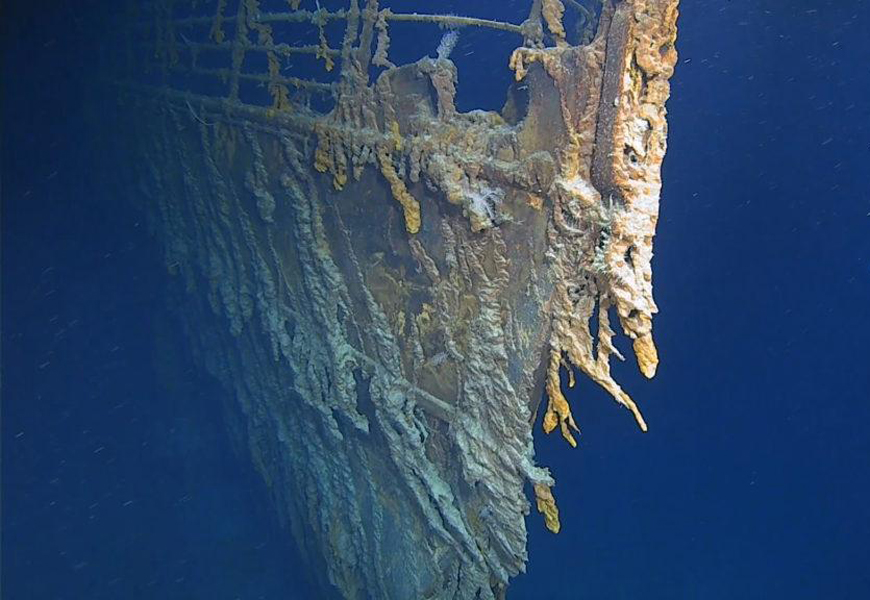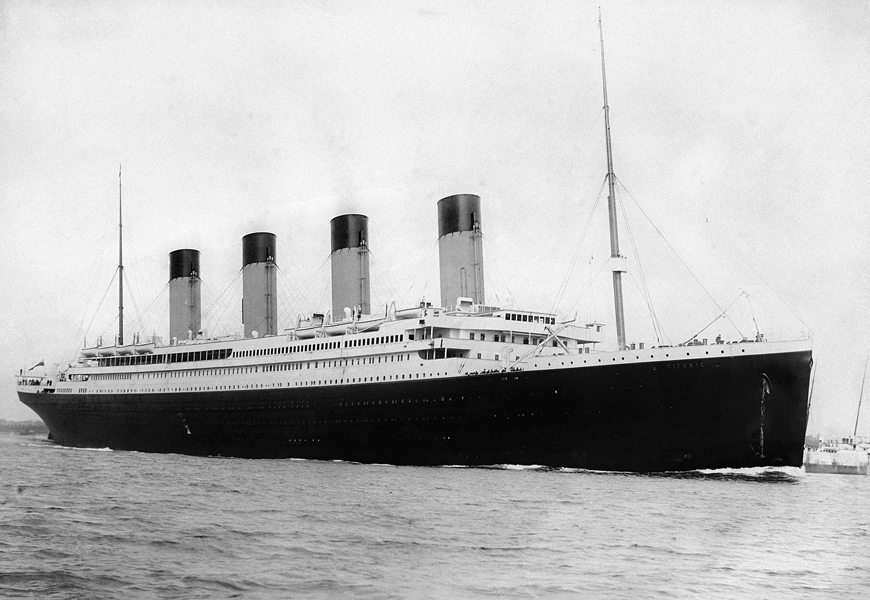More than a century later, the Titanic still draws us in. Why is that?
By Christopher Turner
Earlier this year, a submersible vessel carrying five people bound for the Titanic’s wreckage in the Atlantic Ocean went missing, prompting a desperate search and capturing news headlines around the globe. The passengers’ decision to embark on the $250,000-a-person deep-sea journey run by OceanGate Expeditions, the disappearance of the submersible and the tragic outcome were all covered endlessly in a 24/7 news cycle that catered more airtime to the story than to countless other newsworthy stories. It’s a reflection of the enduring grip that the Titanic, and everything surrounding its sinking, has had on the public’s imagination through the years.
About 1,500 people died the night that the Titanic sank in April 1912, and none of the survivors of the tragedy are alive today (the last survivor, Millvina Dean, who was only nine weeks old when she was a passenger aboard the ship, died in May 2009). But the Titanic disaster has never faded from the world’s imagination. In fact, it is one of the only disasters in history that is perpetually remembered, explored, commemorated and even celebrated.
The way the tragedy unfolded, and the length of time it took to unfold, as well as the variety of people on board, ultimately created endless opportunities for decades of study and analysis. For example, researchers and enthusiasts ask how and why the ship sank, where and when it broke in two, what stories survived and what were lost to the Atlantic Ocean.
Other shipwrecks that were just as deadly – or even more deadly – have been lost to history and never held a grip on popular culture. But the Titanic endures and has continued to captivate people for over 110 years. According to researchers, the ongoing interest – and in some cases, obsession – is partially a result of a human interest in the passengers’ stories and the unique circumstances surrounding the shipwreck. It also has a lot to do with the drama of choice, and not with the disaster itself.
“People are fascinated by the Titanic today for the same reasons they’ve always been.… It’s the implausible story,” says Don Lynch, official historian for the Titanic Historical Society. “The largest ocean liner in the world, on its maiden voyage, supposedly unsinkable, loaded with some of the most famous names of the day, hits an iceberg all on its own, and then sinks so slowly there is a lot of time for drama and heroism to be acted out. If it was written as fiction, no one would believe it could have actually happened.”
James Cameron agrees. The director became fascinated by the real ship and worked the story up into a $200 million shipwreck epic, which soon sailed into the record books as one of the highest-grossing movies of all time.
“The Titanic has a great metaphorical and mythical value in the human consciousness,” Cameron said in a 2005 interview with the Independent. “Is it the most compelling thing in the world when we need to find a cure for AIDS and millions of people are dying in Africa? No, on that scale, it’s not a priority. But you have to think of the Titanic in terms of a feature film or a novel – something that touches people’s emotions. Wrecks are human stories. They teach us something about ourselves. A wreck is a fantastic window into the past. Steel can’t lie – it doesn’t have an agenda. These wrecks are like time capsules. We’ll put parking lots over battlefields, but underwater these sites are frozen in time. By visiting them, we can touch history.”
It’s undeniable that the Titanic has occupied a unique place in human history and lore for over a century. But there is still more to the fascination, and it has to do with drama.

The story
Following completion of the ships construction, the Royal Mail Steamer (RMS) Titanic, a British passenger liner built in Belfast and operated by the White Star Line, was launched on May 31, 1911. It’s estimated that 100,000 people – roughly one-third of the population in Belfast – watched the just-over-a-minute-long launch. Captained by Edward J. Smith, the Titanic set sail on its maiden voyage on April 10, 1912, at approximately 1:30 pm, travelling from Southampton, England, to New York City. After a mere four days at sea, the famed “unsinkable” ship hit an iceberg in the North Atlantic Ocean in the dead of night on April 14, 1912, at 11:40 pm. The Titanic sank over the course of the next two hours and 40 minutes. Of the estimated 2,240 passengers and crew aboard, 1,517 people died, making it one of the worst maritime disasters in history. Some 60 per cent of the passengers who survived were first-class guests. Fewer than 25 per cent of the third-class passengers survived.
Despite numerous efforts, it was another 73 years before the remains of the wreckage were discovered in August 1985, about 600 kilometres off the coast of Newfoundland and almost four kilometres under the water. Dr. Robert D. Ballard of the Woods Hole Oceanographic Institution in Massachusetts and a team of American and French researchers discovered the remains with the help of a robot submarine. It was a discovery that captured the world’s attention like never before.
Our ongoing fascination
Of course, the fascination with the Titanic was ongoing long before the 1985 discovery of the wreckage. The Titanic was already a household name, with a century’s worth of pop culture touchstones, but Ballard’s discovery definitely contributed to our ongoing fascination.
“It’s a never-ending story,” says Paul Burns, vice president and curator for Titanic Museum Attraction (two museums, one in Branson, Missouri, and the other in Pigeon Forge, Tennessee). “Titanic is never-ending. You take the 2,208 or so that were on board, you take the ones that survived, you take the ones that perished, and there’s so many stories.”
There have been countless travelling exhibitions, books, news reports, podcasts and online websites dedicated to tell the Titanic’s stories. To date there have been at least 18 films made about the disaster, from 1912’s Saved from the Titanic (a silent picture released just 31 days after the event starring Dorothy Gibson, an actress who survived the sinking) to Jean Negulesco’s classic 1953 film Titanic (starring Clifton Webb and Barbara Stanwyck, which went on to win the Academy Award for Best Original Screenplay) to Cameron’s 1997 blockbuster Titanic(starring Kate Winslet and Leonardo DiCaprio, which was nominated for 14 Academy Awards and won 11). The most recent release is The Six, a documentary released in 2020 that tells the story of the six Chinese survivors of the Titanic.
While Cameron’s award-winning film and other dramatizations enchanted audiences with a fictional love story set aboard the doomed ship, Don Lynch of the Titanic Historical Society feels that our ongoing fascination goes beyond the power of film. He says most people are actually more interested in why the Titanic sank, rather than what life was like on board for the passengers.
Stephen Cox, a retired professor of literature at the University of California at San Diego and author of The Titanic Story: Hard Choices, Dangerous Decisions, agrees.
“It’s one of the few disasters that had time to develop the full drama of human choices,” says Cox. “Usually if a ship is going to sink, it sinks pretty quickly. Titanic lasted for two hours and 40 minutes, which is as long as a Shakespeare play.”
Simply put, other disasters were either too big or too small to develop the same kind of interest. They happened too fast, or too slowly.
When it comes to disasters, only the terrorist attacks on September 11, 2001, command the kind of enduring attention that Titanic receives, Cox says. After all, the two disasters unfolded over similar time spans, and both included diverse groups of people who were ultimately forced to make decisions about what could be their last moments.
“The Titanic and 9/11 – these disasters, these two, will continue to be remembered, not for their horror, but for what they teach us about the drama, and the dignity, of real people making the ultimate decisions of their lives,” Cox wrote in a 2012 essay for CNN.
The Daily News‘ Helen Kennedy agrees, calling what happened to the Titanic “the first truly global tragedy the 9/11 of its day.”
And both tragedies spawned government agencies: the U.S. Coast Guard and the Department of Homeland Security.
What happens when the ship disappears forever?
One hundred and eleven years later, the Titanic still manages to regularly make the news. Today, the skeleton of the ill-fated luxury ocean liner remains rusting and decaying under the sea, off the coast of Newfoundland. Despite the rapid deterioration of the wreckage, it still captures the public’s imagination and fascinating historians, explorers and everyday people alike. Researchers now say it may only be a couple of decades before the ship has all but vanished.
In 2003, Ed Kamuda, then the president of the Titanic Historical Society, told The Associated Press that human activity, including tourism and expeditions, needs to be limited. He said the site should be a simple maritime memorial and left alone.
“Let nature take back what is hers,” Kamuda said. “It’s only a matter of time before it’s a brown stain and a collection of pig iron on the ocean floor.”
Only time will tell if the rapid deterioration will increase our fascination with the Titanic, but it is probable, considering the sheer interest shown around the globe following the recent OceanGate Expeditions submersible disaster. There’s certainly no lack of information available to anyone of any age interested in getting a closer look. A quick search of TikTok, for example, shows thousands of videos on the Titanic, with billions of views.
“For a lot of us, it’s more than just a ship,” says Rafael Avila, a young enthusiast who is known as “the Titanic Guy” on TikTok. Avila regularly shares Titanic lore with his 659,000 followers, debunking theories about the accident, spotlighting the luxury liner’s features, sharing images of the wreckage on the Atlantic ocean floor and telling the stories of the people who were aboard. Beware, not every Titanic TikTok is worthy of watching: in a TikTok post that garnered more than 11 million views before it was removed earlier this year, one user wrote: “the titanic never sank!!!”
Regardless, the ill-fated Titanic, and the stories surrounding it, will never disappear thanks to the permanent dramatic interest in a story not even Shakespeare could have imagined.
RELATED:
– 30 Fascinating Facts About The Titanic












